CHAPTER XXXIX.
LAKE PARK, SUPERIOR AND TERRILL—SILVER LAKE TOWNSHIP, A LITTLE OF ITS EARLY HISTORY —THE EARLY SCHOOLS—THE FIRST POSTOFFICE —EARLY RELIGIOUS MEETINGS—THE COMING OF THE RAILROAD—THE TOWN OF LAKE PARK—THE FIRST BUSINESS HOUSES AND ENTERPRISES—THE LAKE PARK NEWS—CHURCHES—CIVIC SOCIETIES—POSTOFFICE—INCORPORATION OF THE TOWN—MAYORS—PRESENT OFFICERS—SUPERIOR—THE TOWN STARTED BY THE RAILROAD COMPANY—FIRST POSTOFFICE—THE FIRST BUSINESS VENTURES—POSTOFFICE—INCORPORATION—OFFICERS—THE DESTRUCTIVE FIRE OF 1897—TERRILL —CARPENTER'S WILD RAILROAD SCHEME—THE MINNEAPOLIS & SAINT LOUIS ROAD—THE TOWN SCHOOL—AN INTERESTING EXPERIMENT OF A LIVE TOWN.
LAKE PARK is situated on the northeast shore of Silver Lake, in Silver Lake township. The building of the Burlington, Cedar Rapids & Northern Railroad in 1882 stimulated the building of several towns along the line, and Lake Park was one of the principal ones. The first settlement in Silver Lake township was made in August, 1868, by George Nicholson, who took the first homestead in that locality. He homesteaded some fractional forties on the southeast side of the lake. He took his claim in August, and then went back east for his family. Upon his return in the fall he was accompanied by a young man by the name of Andrew Cloud, who took a claim on the north side, on what afterwards became the home of C. B. Knox. The next year, or in 1869, Cloud sold or disposed of his claim to C. B. Knox. The price paid for claims, even the best, was not enough to make a man vain of his wealth. Other settlers for that year were John Dingwall and James Acheson, and one or two others, who remained but a short time. In 1870 the settlement was increased by the arrival of Alexander Robertson with a large family, and John Dickerson.
In 1871 Nicholson sold out to J. B. Drew. Robert Fletcher and C. Lewis also came in 1871, and John K. Robertson, and possibly one or two others, in 1872. In the Drew or Nicholson Grove there were at the time of the arrival of the first white settlers, the original tepee-poles left standing in place sufficient for spreading some six or seven tepees. Now, while the Indians in moving about the country took enough poles hem to set up a temporary camp wherever they happened to be, they did not take enough along for a very elaborate affair, but at many of the desirable camping places about the lakes and on the streams they had tepee-poles set up which they permanently in place, so that on arrival at any of these permanent camping places, all they would have to do would be to spread their tepees on the framework of poles already in There were several of these permanent camps found by first settlers in 1857. One on the southeast of Loon Lake, one in Marble Grove west of Spirit Lake, one in Okoboji Grove near the old site of the Mattock cabin, one in the grove south of Miller's Bay, and, as before stated, one in the Drew or Nicholson Grove, southeast of Silver Lake. At each of these several places there were poles set up for spreading from six to nine tepees.
After the Indians left and before the white settlers came, Silver Lake was a favorite camping ground for trappers. Every little grove of native timber in northwestern Iowa or southwestern Minnesota has at some time or another been the headquarters of some trapping outfit. In addition to those who made trapping a regular business, most of the settlers had more or less traps which they tended at the proper season, and the fur taken proved an important factor in tiding over many a family of the early pioneers until such times as the original claim could be converted into a farm and made to produce sufficient for the family support.
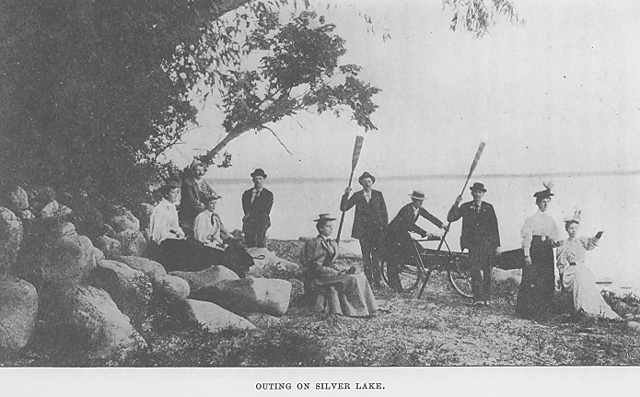
Silver Lake was originally attached to Lakeville township and was set apart from it in 1872. The first school in the township was before it was so set off, or at least before the new organization was completed. The first teacher was Miss Louise Middleton of Lakeville, who was employed by the Lakeville school officers. The first term was in the house of C. B. Knox. His house was a one room affair, possibly about sixteen by twenty feet, and one story high, which had to answer for kitchen, living room and school room alternately. In addition to this, room was always found for any benighted traveler or wayfarer who might put in an appearance. This was before the days of tramps and hoboes. No cabin was so small that the owner would or could be justified in refusing to entertain a worthy stranger—
"Guidance and rest and food and fire
In vain he never must require."
The ,second term of school was taught by the same teacher in the residence of John Dingwall under similar conditions.
One of the first enterprises to receive attention after the town was set off and a separate organization effected was the building of a new schoolhouse. The first schoolhouse was built in 1873 opposite the northeast corner of the lake as soon as possible after the organization of the district was completed. This was known as the Knox Schoolhouse. A second one was built the following year at the southwest corner of the lake and known as the Dingwall Schoolhouse. These schoolhouses were built in good substantial style and supplied with first-class furniture and apparatus. R. B. Nicol taught the first term of school in each of these houses, the first one being in the Knox Schoolhouse in the winter of 1873 and 1874, and the second one being in the Dingwall Schoolhouse the succeeding winter.
After getting things into running order, they adopted the plan of having school in but one of the schoolhouses at a time, that is, they would have a term of school first in one schoolhouse and then in the other, and those residing in the neighborhood where the school was not in session always sent a team with their pupils across to the other schoolhouse. In this way a more regular attendance was obtained and they were enabled to secure the most competent teachers. Indeed, so far as school matters are concerned, Silver Lake has ever been one of the most liberal and progressive townships in the county. They always employed the most competent teachers to be had. They paid the highest wages and furnished the most improved facilities of any in the county, and in a general way took a more active interest in school matters than is usual in a new country. The plan which they first adopted was followed about ten years, or until the building of the railroad so changed conditions that new deal was in order.
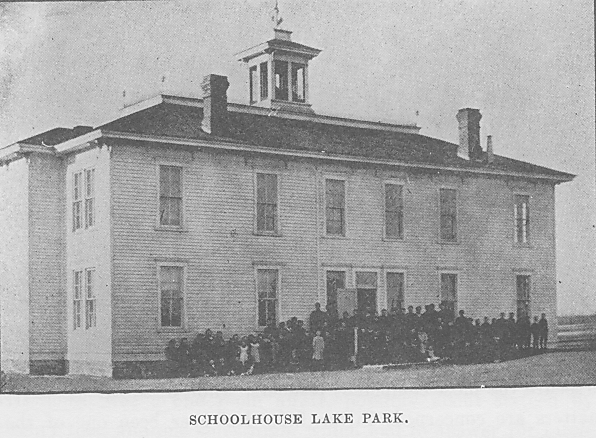
The first census in which the population of Silver Lake was reported separately was that of 1873. In that report the population is given as sixty-seven, and in 1875 as fifty-nine, and in 1880 as forty-five. From 1873 to 1877 inclusive were the grasshopper years, which accounts for the growth being the wrong way. After the grasshoppers left it was some years before people in search of a location would favorably entertain the idea of settling in a country so recently ravaged by tale pests. This accounts for the slow development of the county during the five years subsequent to their disappearance.
A postoffice was established in 1872, C. B. Knox, postmaster. The name of the office was Austin. Why that name was adopted does not appear. Two mail routes had been established a short time before, one from Spirit Lake to Sibley and the other from Spirit Lake to Worthington. The Austin mail was carried over both of these lines, they following the same route as far as Silver Lake, when they separated, one going to Sibley and the other to Worthington. The mail was carried weekly over each route, one trip being made in the early part of the week and the other in the latter part.
The first religious services in the township were conducted by Rev. J. R. Upton, in 1870 or 1871. Mr. Upton's work at Milford, Lakeville and Spirit Lake has been noticed at some length. About the same time Rev. G. Brown, of the M. B. Church, held one or two services at the residence of J. B. Drew. D. W. Lounsberry, an early settler, held services here pretty regularly for three or four years, though not employed or sent here by any denomination. After the first schoolhouse was built in 1873, the meetings were for the most part held there. Before that time they were held at the homes of the few settlers. Rev. J. B. Edmunds, who originally had a, homestead on a portion of the Willow Spring farm, held services there for some time. None of these early services were maintained by any of the established churches, but were the result of arrangements between the settlers and the several preachers.
The Burlington, Cedar Rapids & Northern Railroad was extended west from Spirit Lake in the summer and fall of 1882. The site selected for the new town was a portion of section 27, township 100, range 38. Dr. Henry Shimer of Mt. Carroll, Illinois, was the original proprietor. The plat was filed for record August 18, 1882. The first building on the town site was a general store by William Thompson. Some of the first business ventures were as follows: Armin & Riley were the first in the grain and lumber business, they having started in 1882. In 1887 they sold their business to Stockdale & Bahls, who materially enlarged it and added live stock as well. They had previously been in 'the grain business, having built the first elevator in 1884. Harvey & Truesdale started a hardware store about the same time, while W. S. Bowles put up and operated the first blacksmith shop in the town. The pioneer hotel was built by Anthony Arnold and was conducted by him up to 1888, when he sold out to Major E. P. Bing, who improved it and conducted it for several years. Mr. Ring also in connection with the hotel, conducted the first livery barn in the place.
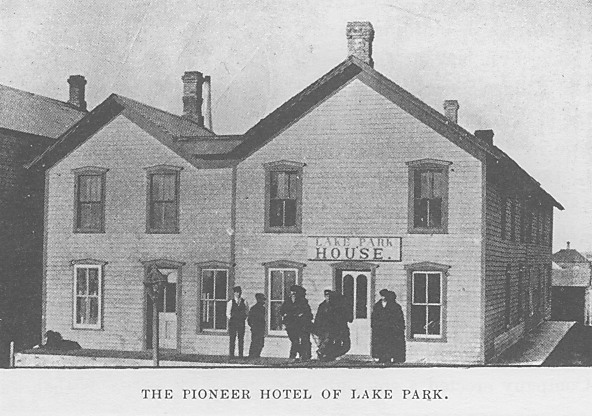
The first physician to hang out his shingle was Dr. Beebe in 1885, and the first drugstore was started a year or two later by Dr. C. E. Everett, formerly of Spirit Lake.
S. Benson put in the first restaurant in Lake Park, and afterwards he put in a stock of dry goods and was succeeded in the dry goods business in 1887 by Strathman & Bock. The first real estate and insurance man was S. M. Thomas. L. Stoltenberg was the first to handle farm machinery, he having started in that business as early as 1885. Indeed, most of the branches of the business represented in town were started about that time, many of them in a small way and might now be considered insignificant, but all the same they were the pioneer movements in building up the town.
The first butcher shop was started by John Hunt in 1888. Ole Knutesen was the first shoemaker. At first he worked in the back part of Thompson's store, but put up a building of his own in 1886. The first furniture store was by J. T. Benson in 1890, and the first harness shop was by Elmer Buffum in 1891. He was succeeded by D. C. May, who erected one of the first three brick buildings in town. The first barber in town was Frank Dunbar. The first man to engage in the business of baling and shipping hay was H. H. Kitts.
As time passed there came a demand for larger and better buildings and better business facilities. In 1888 Koester & Company erected a store and put in a stock of goods that was considered a long way ahead of anything before attempted. Theodore Strathman, one of the members of the firm, was general manager of the concern.
In 1885 Mr. C. P. Bennett purchased several tracts of land on the south and southeast of Silver Lake with the object in view of rearing fine stock. In building up his extensive improvements, his aim all of the time has been to have everything first-class. Ample means has enabled him to indulge this propensity to its fullest extent. In stocking his farm the same rule has been observed, until his herd of Hereford cattle are known among stock raisers and dealers as one of the finest in the middle west. Mr. Bennett has been a mascott to Lake Park in more ways than one.
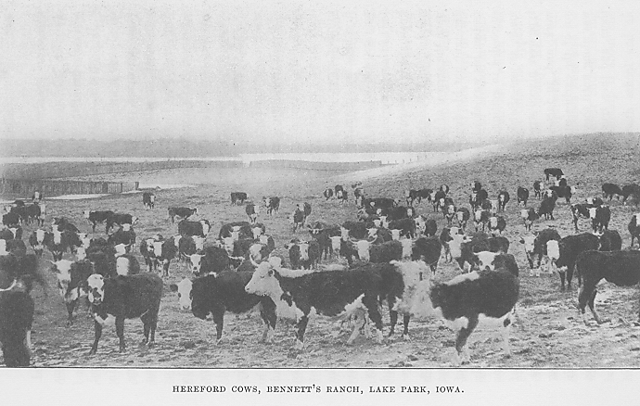
Every live town is supposed to have a live newspaper, and Lake Park is certainly no exception to this rule. The Lake Park News was established in 1890 by A. B. Chrysler, the first number appearing Friday, September first, of that year. The first issue was about three hundred copies. It was uphill business getting out the early numbers of the News. Mr. Chrysler had never worked in a printing office a day in his life and knew absolutely nothing of the proper disposition and arrangement of the furniture and fixtures of a printing office, and yet, upon the arrival of his material, he tackled the job and with no assistant but his daughter, a bright girl of twelve, by dint of feeling his way along and by numerous experiments, he finally succeeded in getting things in working order. The only error made, as was afterwards shown, was that some of the eases of type were placed wrong side to. In the composition and press-work, and, in fact, in everything connected with the getting out of the earlier numbers, it was cut and try and feel their way along until they had things as near right as they could get them, and then trust to luck for results.
Among educators, a favorite motto is: "Learn to do by doing." Well, this is the way Chrysler learned the printing business. It is related that on one occasion Mr. Chrysler was unexpectedly called away, leaving the office in charge of his daughter, who, nothing daunted, tackled the job of getting the paper out on time, which she succeeded in doing, and by the way, some people declare it was one of the brightest numbers ever issued. They started in working off three hundred copies and have increased the number until now it requires seven hundred. In 1897, J. D. Flint and H. C. Darland purchased the outfit and conducted the paper a little less than two years, when they turned it back to its first owner. The News was one of the official papers of the county from 1891 to 1896.
The pioneer schools of the township have already been noticed quite extensively. After the starting of the town in 1882, the old Knox Schoolhouse was made to do duty for a year or two, when more room was needed. In 1884 a new two room building was erected, but this soon proving too small, two more rooms were added. Five teachers are employed and the old time interest maintained.
The religious denominations represented in Lake Park are the Methodists, the Presbyterians and the Catholics. The early religious services were decidedly cosmopolitan and it was not until about 1883 that denominational lines were drawn to any appreciable extent. In that year the Methodist Episcopal Church established the Lake Park circuit, which was placed in charge of Rev. Hild. Since that time the appointments on the circuit have been Reverends Cheney, Keister, Woolery, Olds, G. W. Barnes, J. C. Clearwater, — — Shoemaker and W. H. Prugh. The Methodists were also the first to erect a church building in town, their church having been erected in 1891. The present membership is about one hundred and ten. An enthusiastic Sabbath school and an active branch of the Epworth League are maintained, and everything pertaining to the church is in a prosperous condition.
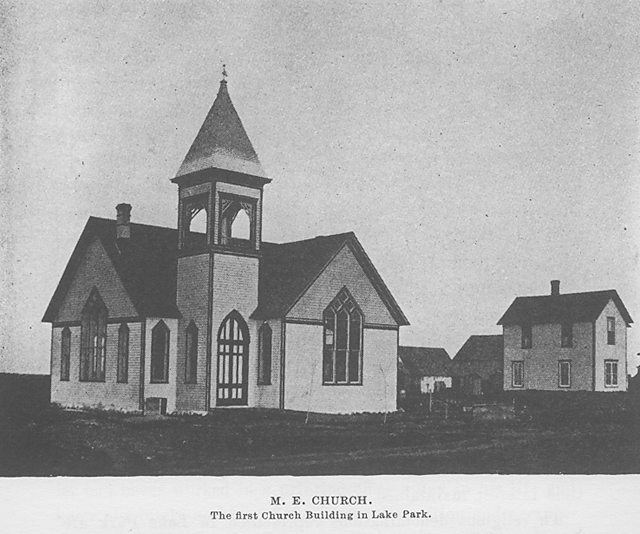
The preliminary steps for organizing a Presbyterian Church were taken early in 1893 and an organization effected the same year. Through the active efforts of Reverend Clapp, and the hearty cooperation of resident members, the society was soon in a prosperous condition. They started in with eight members and from this the membership has increased until now the number is about forty. A neat and commodious church building was erected in 1895 and Doctor Bailey preached the dedicatory sermon. Previous to this time the meetings were first held in the schoolhouse and later on in a hall over the blacksmith shop. The resident Presbyterian ministers have been Rev. M. T. Ramer, Rev. — Valier, Rev. Joseph Mapeson and Rev. F. E. Hoyt. An active Sabbath school has been maintained from the start and also Christian Endeavor and Christian Endeavor Junior societies have prospered.
The civic societies represented are the Masons, Odd Fellows, A. O. U. W. and the Modern Woodmen. Silver Lake Lodge, No. 527, A. F. & A. M., was organized under dispensation, April 15, 1893. They received their charter in August of the same year. The first officers were: Theodore Strathman, W. M.; John Linder, S. W.; Frank Buffum, J. W.; John Buffum, Treasurer; J. M. Buffum, Secretary; G. A. Triggs, S. D.; W. W. Harris, J. D.; A. A. Kingsley, S. S.; J. W. C. Salyard, J. S.; J. M. Dunlap, Tyler. Masters since that time have been Theo. Strathman and D. C. May. The present elective officers are: Theo. Strathman, W. M.; G. A. Triggs, S. W.; Jacob Graham, J. W.; E. F. Nye, Treasurer; D. C. May, Secretary.
Lodge No. —, I. O. O. F., was organized in October, 1895. The first officers were : W. B. Higbee, N. G.; M. D. Green, V.G.; C. W. Flint, Secretary, and H. F. Asmessin, Treasurer. Since the first organization the N. G.'s have been M. D. Green, C. W. Flint, C. Hayden, F. L. Ackerman, H. G. Flint, H. Bock, W. Wright, G. W. Burrows and Edward Hudson. The lodge was at first organized with seven members but had thirty-one initiations at the first meeting. The present officers are: E. Hudson, N. G.; C. S. Shultz, V.G.; Otto Schmeoser, Recording Secretary; Edward Buffum, Financial Secretary; H. L. Asmessin, Treasurer. The present membership is about eighty. A Rebecca lodge of about fifty-six members was organized near the close of the year 1899 and has been very flourishing from the start.
A lodge of the Ancient Order of United Workmen was organized in the nineties, but not being well supported was allowed to lapse until in February, 1900, a reorganization was effected and officers chosen as follows: H. C. Knox, M. W.; G. A. Stouffer, P. M. W.; G. W. Palmer, Recorder and Financier. Since the first the Master Workmen have been, August Kruger and C. W. Turk. Present membership is about twenty-five.
A camp of American Yeomen was organized some time in 1897. The first officers were: W. B. Higbee, Foreman and J. G. Chrysler, Correspondent. For some reason the lodge meetings have not been kept up of late, but a few of the prominent members are keeping up the reports and grand lodge dues in order that the organization may not lapse and the charter be forfeited. The present membership is about twenty-seven.
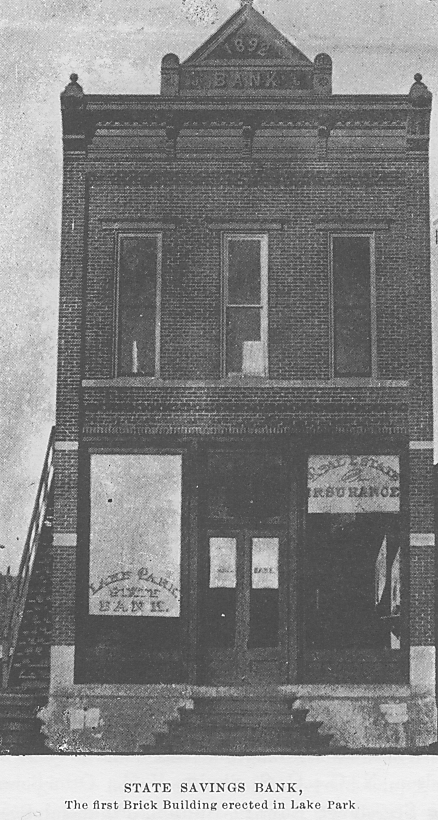
The first banking institution in Lake Park was the private banking house of Green & Patch, which commenced business in 1889. One year later they organized as the Lake Park State Savings Bank, with John W. Cravens, President, and M. D. Green, Cashier. The State Savings Bank was the first brick building erected in Lake Park. The present officers are John W. Cravens, President, and A. C. Robertson, Cashier. A few years later a second bank, the German Savings Bank, was organized, with Louis Stoltenberg, President, Theo. Bahls, Vice-President, and 'Theodore Strathman, Cashier.
About 1882 the name of the postoffice was changed from Austin to Lake Park and William Thompson appointed postmaster. At the time of Cleveland's second election, he was succeeded by Ira Breffle, who in turn was succeeded by A. B. Chrysler.
The town of Lake Park was incorporated in August, 1892. The first officers were: Mayor, John Buffum; Recorder, Theodore Strathman; Councilmen, H. H. Rohlf, D. C. May, E. P. Ring, F. W. Tutin, John Linder, William Patterson. The mayor's office has since been held by A. B. Chrysler, G. NV. Burrows, C. S. Shultz, W. F. King, James Patterson, Theodore Strathman and L. Benson. The present officers are : Mayor, L. Benson; Recorder, August Sindt; and Councilmen, W. S. Wright, S. W. Brefe, John Linder, M. D. Green, J. G. Chrysler and H. C. Meyers. The population of the town according to the census of 1900 was 541, which was an increase of about 150 from that of five years before.
The fact has already been mentioned that at the time of the building of the Burlington, Cedar Rapids & Northern Railroad, the question of voting subsidy to aid in its construction was submitted to the voters of Superior township and the proposition was defeated, but later on, upon the railway promising to build and maintain a station within the township, the former action was reconsidered, and on the question being submitted a second time, was carried by a good majority. The railroad was built through the township in the spring of 1882 and a depot built the ensuing year; Frank Taylor, station agent. This same year W. S. Gardner purchased the quarter section adjoining the town site on the west and soon after commenced business in town by putting in the first general store. It would not be counted much of a store now, but answered all purposes when it was built. At first he carried only groceries but later on increased his stock by adding a general stock of such goods as are usually found at a country store, and as business increased he took a hand in about everything going. He bought and shipped the first car load of hogs and the first car load of grain shipped from the station. It was before the day of elevators and stockyards. He also handled coal and farm machinery.
Ed Fogarty was the first regular grain buyer. The first lumber yard was started by Roberts & Sullivan, in 1885. Subsequently they sold out and were succeeded by the Farmers' Cooperative Company. This was an organization made up of farmers, the object of which was to do away with the middlemen and to enable them to ship out their own grain and stock and ship in their own coal and lumber. They employed D. L. Wylde as agent and manager. In addition to handling the produce of their own members, they bought and shipped grain and stock and sold coal and lumber. They also handled farm machinery. They continued in business about five years when they dissolved and were succeeded by one of the elevator companies.
The second store in Superior was erected by Warren Hurd about 1584, and was occupied by David Mitchell as a general store. He also carried a line of farm machinery.
The first hotel was built, and conducted by D. E. Hurd back in the eighties, while the first livery barn was put in by Warren Hurd and conducted by Frank Coyle. A somewhat more pretentious block was erected in 1889 than had been previously attempted and was used for various purposes—as bank, newspaper office, drugstore and several other enterprises. The first bank, the Superior Savings Bank, was started in 1890 by W. W. Hurd. About this time or a little later, a newspaper the Superior News, was established by F. Finch. This paper was published until 1897, when the entire outfit was destroyed by fire and no attempt has been made to start up again.
The Superior postoffice was first established in 1883 and W. S. Gardner appointed postmaster. He kept the office at his residence on the farm the first year, but he soon found it a great nuisance. Indeed, that was one of the considerations that induced him to put up a building and go into business in town. He held the office until 1890, when he was superseded by David Mitchell,,who, after holding it two years, was in turn succeeded by D. L. Wylde. Mr. Wylde's successor was E. J. Olesen, the present incumbent.
The first religious denomination to get a foothold in the town were the Baptists, who organized a society soon after the town was started. They erected a church building, the first in the town, in 1890. Elder Braistead of Spirit Lake was the first minister to hold services here. This was previous to erecting the church building. Subsequent pastors have been Randall, Fay and Elder Sloan. The present pastor is Elder Hamilton. The Methodist Episcopal Church has also had an organization here from the first, a part of the time holding their services in the schoolhouse and later on alternate Sundays in the Baptist Church. In 1901 they erected their first church building. A two room schoolhouse was built as early as 1886, and two teachers have been regularly employed since that time.
In 1897, a considerable proportion of the business part of the town was destroyed by fire. The bank, hotel, drugstore, printing office, the dry goods and furniture store of J. P. Nelson, the general store of D. L. Wylde, the restaurant of T. Trowbridge, and various other interests were wholly destroyed. Some of them were afterwards rebuilt, but it was a long time before the various business interests recovered from their losses. Some of them never did.
Superior never had a rapid growth, and yet in some branches the business is much larger than in many towns of twice its size. In grain and stock, and in coal and lumber, the business done is phenomenally large, while all of the ordinary branches of trade in a small country town are well represented. Of course, as is always the case, no sooner was business once started than changes began to take place. New enterprises were inaugurated and the old ones passed into new hands, but it is not possible nor is it desirable to follow these changes in all their details.
The town was incorporated in February, 1896. The first meeting of the town council was held March 6, 1896. The first officers were as follows : L. Broderick, Mayor ; John Jacobs, Assessor ; G. M. West, Recorder, and L. F. Kleibenstein, M. C. Hogle, D. L. Wylde, C. D. Sergeant, T. Trowbridge and J. P. Nelson formed the council. The Mayors since the first have been J. C. Smith, John Jacobs and L. F. Stevenson. The present incumbent is O. C. Trueblood, and J. P. Nelson, Recorder. The census of 1900 gives the population of the town as 187 and of the township, 728.
During the summer of 1894 or 1895, a scheme was inaugurated and a company organized under the high sounding name of the Manitoba & Gulf Railroad Company for the purpose of building a link in the proposed railroad from Manitoba to the Gulf of Mexico. The originator of the scheme was a Mr. Carpenter and he had a few others associated with him. They hadn't a dollar capital at their command, but they didn't intend to allow a little thing like that to interfere with their enterprise. They started in with as much flourish and parade as though they had millions hack of them. Their plan was to organize a local company, get all the subsidies they could, get as much right-of-way as they could, do a little work, and then induce some established company to take the enterprise off their hands.
In Jackson County, Minnesota, they succeeded in securing quite a subsidy, but the people of this county didn't bite worth a cent. They had seen that game before and no subsidies were voted, but the company went on with their survey and commenced work all the same. Their line was through Lloyd, Richland and Superior townships in this county, and in the direction of Jackson, Minnesota. During the summer and fall of 1895 the work was pushed as rapidly as possible under the circumstances. The grading was mostly completed across Richland township and some done in both Lloyd and Superior. Before the year ended the company collapsed beyond all possibility of resurrection.
In the meantime, a movement had been started to build up a town near the center of Lloyd township. The tract selected was a part of Section 15 and was owned by E. E. Taylor, who had it surveyed, platted and put on record in the summer of 1895. The first name hit upon for the new town was "Trilby," but upon applying to the department for a postoffice, it was ascertained that there was already one postoffice by that name in Iowa, and so the name Terrill was substituted in its place. A store, bank and hotel and some other buildings were erected this season. Among the first business ventures in the new town were the hotel by J. R. Phelps, a dry goods store by C. II. Avery, the Terrill Bank by Taylor & Ewert, a hardware store by Sharkey & McNary. Other branches of business were represented, but when the collapse of the railroad scheme came most of the enterprises were suspended for a time or laid off altogether. Some of the buildings were moved away and others closed for the time being.
When the officers of the Minneapolis & St. Louis Railroad were looking up their route from Estherville to Spencer, they decided to make Terrill a point on their line, and to that end utilized a portion of the roadbed of the defunct Manitoba Company. The first survey was a little east of Terrill, as being nearer in a direct line between Estherville and Spencer, but it was finally decided to make Terrill a point. Mr. Taylor, the town proprietor, donated the right-of-way through the land he was interested in and there were others. The road was built in 1899, being the third in the county. Quite a strong effort was made by the business men of Spirit Lake to induce the company to locate through the center of the county, making Spirit Lake and Milford points on the line, but without avail.
Of course, the building of this line gave the town a new lease of life. The old buildings were overhauled and renovated and new and better ones erected. Every line of business common in a country town was soon represented. The town is situated in the center of one of the best agricultural tracts in the country, and is peculiarly well located for dealing in farm produce and coal and lumber, and the business in those two lines is away beyond what is ordinarily done in towns of the size of Terrill. Two elevators and two first-class lumber yards find a good business. The German Lutherans and the Methodists have each erected church buildings within the last two years and the Congregationalists are preparing to erect one in the near future. The first term of school was taught by E. E. Heldridge
The town was incorporated in 1899 and Howard Everett elected the first mayor. For some reason the organization was not completed in time for the town to show up in the census returns of 1900. The population of Lloyd township for that year is given as 623. D. M. Shaffer was the first postmaster and after the building of the railroad he was succeeded by J. C. Blow. The Terrill Tribune was established in 1899 by E. Taylor, formerly of the Traer Star-Clipper, and Mr. John Hayden. At the end of the first year, Mr. Hayden bought out Taylor's interest and has since managed it alone and is fast bringing it to the front as a readable and reliable paper.
Lloyd was the first township in the county to adopt the township school system so strongly advocated by the state superintendent. Action in the matter was taken at the spring election in 1901 and a schoolhouse erected the same summer. The schoolhouse is a modern four room building, fully up in appearance to those in the larger towns. Three teachers are employed the current winter. So far the scheme has proven highly satisfactory. The experiment will be watched with a deep interest in the other parts of the county. The town has been started so short a time that as yet it can hardly be said to have a history.